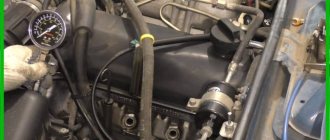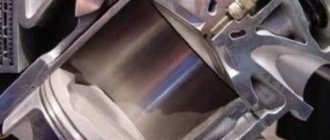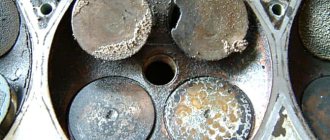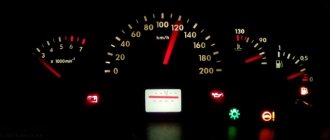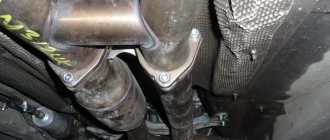The compression pressure in all cylinders should not differ by more than two units. Note that the compression amount should increase quickly on a healthy engine; Low compression pressure on the first revolution of the crankshaft accompanied by a gradual increase in pressure on subsequent revolutions of the crankshaft indicates wear on the piston rings. A low pressure value at the first revolution of the crankshaft, which increases slightly thereafter, indicates a loose valve fit, a broken cylinder head gasket or a crack in the cylinder head. Worn valve stem ends can also cause low compression pressure.
Opel does not determine the exact compression pressure, but if the compression pressure in the cylinders is less than 10, this indicates engine wear.
If the pressure in one cylinder is low, carry out the following test. Pour some engine oil through the spark plug hole into the cylinder and check the compression pressure.
If pouring oil into the cylinder increases compression pressure, this indicates that the cylinder or piston rings are worn.
Low pressure in two adjacent cylinders indicates a burnt gasket between the cylinders.
If the pressure in one cylinder is 20% less than the others and the engine idles rough, this indicates a worn camshaft cam.
If the compression pressure is too high, this indicates that the combustion chamber is coated with a thick layer of carbon deposits.
After this check, screw in the spark plugs and connect the high-voltage wires to them.
Compression is the highest level of pressure in the engine cylinders during the combustion process of the combustible mixture. If there is no compression in one cylinder or several at once, then this problem needs to be corrected urgently. What are the signs and causes of low compression? You will learn more about this here.
Signs and causes of disappearance
There are actually quite a few signs and reasons why there is no compression in one, two or all cylinders at once. Therefore, for users of our resource, materials have been collected that can help determine a decrease in the pressure level in the system.
Signs
If a gasket burns out in the cylinder head, the tightness of the cylinder itself is immediately compromised. This can be seen if exhaust gases begin to escape through the resulting gap. At this moment, the rings become stuck, which entails increased consumption of motor fluid and gasoline. In addition, in some cases, the engine power may increase, and smoky exhaust will come out of the exhaust pipe.
Cylinder operation diagram
If your car has lost compression in all cylinders at the same time or in just one of them, then the signs may be as follows:
- the engine became much more difficult to start;
- the engine is unstable, both at idle and while driving in gear, at all speeds;
- you noticed that your “iron horse” began to consume much more fuel;
- problems also began with the cylinders;
- if your car is equipped with a diesel internal combustion engine, then while the engine is running you will hear frequent popping noises;
- The pressure in the cooling system pipes increases.
Causes
What could be the reasons? There are a lot of them, but we will look at them all:
- cracks have appeared in the exhaust valve device, as a rule, this is caused by wear of the motor;
- the exhaust valve fits very poorly, which entails leakage through the place where the valve comes into contact with the “seat”;
- the valve “seat” itself is completely destroyed or has mechanical damage;
- The cylinder head gasket has burnt out. This could happen due to wear and tear. In addition, the cause of gasket wear may be contamination on the contact surfaces of the gasket. It can also burn out as a result of engine overheating, which will subsequently lead to cracks on the block or deformation of the cylinder head or the block itself;
- due to engine overheating, cylinder scuffing may occur;
- the cylinder-piston group in your engine is worn out;
- the inter-ring bridges of the piston have failed, that is, they have collapsed;
- in addition, the reason why there is no compression in one or two cylinders may be a failure of the intake valve;
- a crack has formed in one or more cylinders or on the pistons themselves;
- carbon deposits have appeared on the oil seals and piston rings, which reduces the pressure in the system;
- there are malfunctions or malfunctions in the operation of the gas distribution system;
- broken chain or timing belt. If the timing belt or chain breaks while driving a car, this may well be the reason why the valves are bent;
- the valve has stopped closing or there is a large gap when closing it. If the gap is too large, then the valve most likely does not open enough, which may be caused by incorrect adjustment or wear of the elements. Additionally, if there is not enough air flowing to one or more of the cylinders, you will hear a knocking sound under the valve covers.
The concept of compression
Compression is the maximum pressure for the combustion chamber that is created by the piston inside the cylinder when it reaches top dead center (TDC) on the compression stroke.
Measurements are needed to check the tightness of the chamber. In this case, the tightness of the assembly depends on the current state of several important elements:
- pistons;
- compression rings;
- valve with seat;
- cylinder head gaskets;
- thermal gap in the timing belt.
There is actually nothing fundamentally difficult about measuring compression in an engine. After checking, you can understand what faults there are in the engine and how long the internal combustion engine will last in this condition.
Considering the information content provided by compression measurements, such a diagnostic procedure has become very common and in demand.
Despite the general principle of operation of internal combustion engines, the design of engines on different cars differs. Hence the different compression ratios.
To determine the optimal parameters of a particular machine, you need to look at the technical documentation. It is these numbers that you should rely on when taking measurements and comparing them with the optimal ones for your car.
Take into account one more important point. Compression measurements on engines that have been in use for a long time do not necessarily have to strictly comply with the standard. Due to gradual wear, compression drops. But as soon as the drop goes below the limit value, this is a signal about wear of the engine CPG. Therefore, the engine will need a major overhaul.
Compression differences between cylinders may vary slightly. But the deviation should not exceed 1 kgf/cm2.
In other words, it is not always necessary to strive for ideal values. The main thing is that the engine is in good working order. Error is always allowed.
How to check compression?
Using a compression gauge
To understand whether your engine has compression or not, you need to use a compression gauge. The measured level must match that indicated in the service manual for your car. The measurement procedure itself must be carried out on a motor with a working electric starter drive system and a powerful battery. Otherwise, achieving an accurate result will be very difficult.
So, you will need a compression gauge. It is, in fact, a regular pressure gauge, only with extensions and adapters for spark plugs of various sizes installed on it. Please note that the compression gauges for diesel and gasoline cars are different, since the pressure level in a diesel engine is much higher than in a gasoline engine. Today, the cost of one compressor can vary from 25 to 50 dollars. This is about 250 - 1,300 hryvnia (800 - 5,000 rubles).
Checking with a compression gauge
- First of all, open the hood, unscrew and remove all the spark plugs from the connectors.
- Then you should prepare the compression gauge itself. To do this, decide which adapter and extension cord you need, after which you need to connect it all.
- Then the adapter from the device must be carefully screwed into the spark plug connector, insert the key into the ignition switch and turn the starter. If you have a vehicle with a diesel engine, you will also need to unscrew the injectors.
- Check the pressure level in each cylinder.
- Check the compression gauge readings with those specified by the manufacturer of your car. Thus, you can draw a conclusion about the condition of the piston group of your engine.
Oil check
You can also check whether there is compression in one or two cylinders or not using regular engine oil. Pour about thirty to fifty grams of liquid into the socket of the unscrewed spark plug, and then check the level again using the device. If you see that the compression level has increased sharply, and the difference in levels between the cylinders has disappeared, then this may indicate one thing. The rings or their seals are coked in your engine.
In this case, consider yourself lucky. Because you can replace oil seals at home. If the problem is in the rings, then the situation here is a little more complicated, since the cylinder head will have to be dismantled. However, this procedure is not particularly complicated and, accordingly, not particularly expensive.
Let's try to diagnose it ourselves
Of course, all these reasons, the questions “why” and why it disappeared, or simply low compression in gasoline and diesel engines, need to be dealt with by a specialist. Although there is a fairly simple way to determine for yourself what the reason is that, say, the same VAZ 2109 engine has extremely low compression on one of the cylinders. There are two relatively simple ways to check why there is no compression:
- oil check;
- compressor check.
They do not claim to be 100% reliable, but they are quite capable of indicating the direction in which to move.
We check with oil. The easiest option
If you pour a little (fifty grams) of engine oil into the hole from the turned-out spark plug and check the compression level again, you may find that it has increased sharply and the difference in compression levels between the cylinders has disappeared. This can only mean one thing: the rings or seals on them are really stuck. We can assume that we got off quite easily, since changing oil seals, in principle, can even be done by a non-specialist or a motor mechanic who is not very highly qualified. With the sealing rings, the situation is, of course, more complicated; you will have to remove the cylinder head (on the same VAZ 2109 engine). However, the operation is still not very complicated both in terms of time and manufacturability. Therefore, not very expensive.
We check with the compressor. Where it hisses, it’s broken
If low compression in one cylinder that was subjected to an “oil test” did not rise, then the malfunction is more complex. Again, you can try to determine on your own what happened, why the compression in one cylinder is low, or has completely disappeared. This is where a compressor can help you. Simply compressed air is supplied to the hole from the spark plug. Where the gasket is broken, there will be a hissing sound (you will have to listen carefully). If compressed air escapes from the exhaust pipe, then the cause of the malfunction is the intake or exhaust valves. We'll have to change it.
Gurgling in the water cooling system - the gasket is burned out
If there is hissing and gurgling in the water cooling system of an engine (both gasoline and diesel), it means that the reason for the loss of compression in one of the cylinders is the blown head gasket. By the way, in this case it will be necessary to check the oil in the crankcase. It is likely that not only compressed air and gases escape through the crack in the gasket, but also water enters the engine crankcase. If compressed air escapes from other holes in the spark plugs, this means there is a breakdown in the block itself, and only a specialist can deal with the malfunction (if he can).
Increase compression level
At home, this is only possible if the cause of its appearance is carbon deposits on the pistons and cylinders.
- You will need denatured alcohol and kerosene. Mix 25 grams of each in a 1:1 ratio. This amount is needed for one cylinder. Accordingly, four cylinders will require four times more mixture.
- Then warm up the engine to operating temperature.
- Approximately 50 grams of the resulting mixture are placed into each cylinder through the spark plug hole. So the car needs to be left for 10 hours. After 10 hours, pour a little oil into each cylinder and start the engine, it should run for 20-30 minutes. The carbon deposits from the exhaust gases should burn out.
Consequences
The most negative consequence of different compression occurs due to incomplete combustion of the air-fuel mixture. If there is no ignition in the cylinder, when the engine is running, the fuel supplied to the combustion chamber washes away the oil film from the cylinder walls. This leads to dry friction and increases wear on piston rings, pistons and cylinders. Long-term use of a car with similar symptoms can result in overheated piston rings, scuffing on the piston skirts and cylinder walls.
Sporadic misfires also negatively affect the operation of the power system. Unburned fuel enters the exhaust system in large quantities. The lambda probe detects a lack of fuel in the exhaust gases, causing the ECU (Engine Control Module) to reduce the injection time. As a result, the mixture in all cylinders becomes lean.
Multiple misfires are dangerous for the catalytic converter. Unburnt fuel accumulates in front of the catalyst in large quantities. Its simultaneous ignition due to high temperature can lead to melting and damage to the neutralizer honeycombs.
Many of today's engine management systems, designed to meet stringent environmental regulations, are capable of shutting off fuel to cylinders where multiple misfires are detected.
Video “Measuring compression in the engine”
We invite you to learn how to measure blood pressure yourself.
What is the first thing they do when diagnosing an engine? That's right, they measure the compression in the cylinders. Many believe that its value determines the health of the engine. The authors find out whether this is so during the next analytical examination.
Compression is a vulgarism. That's right - the pressure at the end of the compression stroke. This is the pressure that is created in the cylinder when the ignition is turned off (or without fuel supply - for a diesel engine) with the piston position at top dead center. So, many diagnosticians, based on the measured compression (sorry, science, for the jargon!) give a conclusion: “the patient is alive” or “to the morgue,” that is, for major repairs.
According to many advanced motorists, compression is almost everything for an engine! But is it?
Experienced experts say...
However, you should always take into account that the most common malfunction, due to which there is a drop in compression in the cylinders of a car engine, is, after all, a burnout of the cylinder head gasket. Then it really makes sense for the driver to try to remember whether he overheated the engine recently. Then (this is what experienced specialists do) simply check the oil level dipstick. If a characteristic white emulsion or foam is observed on it (this happens when antifreeze gets into the crankcase), then we can talk about a gasket breakdown with almost one hundred percent certainty.
What else is worth reading
How to increase engine compression
White carbon deposits on spark plugs
How to check glow plugs
Is it necessary to warm up a diesel engine?
Compression and compression ratio are the same thing: the first fairy tale
No not like this! Compression is the pressure in the cylinder, the compression ratio is a dimensionless parameter that describes the geometric parameters of the cylinder: it is the ratio of the total volume of the cylinder to the volume of the compression chamber (the compression chamber is the volume of space above the piston at its position at TDC (it is also called the volume of the end of compression - this is the same thing). Calling it a combustion chamber is incorrect, since fuel combustion occurs throughout the entire volume of the cylinder.) Compression depends on the compression ratio, but the compression ratio does not depend on compression! Compression also depends on a bunch of parameters: compression start pressure, valve timing adjustment, temperature at which the measurement is carried out, leaks from the combustion chamber. And leaks are determined by wear of the rings and cylinders.
“Compression” is the maximum pressure that we measure in the cylinder when the ignition is turned off.
Repair
As I wrote above, it’s really difficult to make repairs yourself. Unless, of course, you have a blown gasket, it’s possible to repair it, but again, it’s not so easy. How to replace a short video.
Diagnostics are carried out with the cylinder head removed - here the malfunction can be determined 100%. You are unlikely to do it yourself; contact specialists at a service station, or people who understand.
I think my article was useful to you - read our AUTOBLOG.
(
28 votes, average: 4.11 out of 5)
Increased compression - increased power: the second fairy tale
Not certainly in that way. Compression can be increased in two ways - increasing the compression ratio or reducing leaks from the combustion chamber. Let's see what happens in each case: we have a stand at our disposal.
First, let's reduce the volume of the compression chamber. The easiest way to do this is to grind the bottom plane of the cylinder head. The base engine of the “eleventh” VAZ has a cylinder displacement of slightly more than 370 cubic meters. With a standard compression ratio of 9.8, the volume of the compression chamber will be 42.6 cm³. You can calculate that by removing 2 mm from the seating surface of the cylinder head, we reduce the volume of the compression chamber by 5.1 cm³. The new compression ratio will be 11 units, that is, 1.2 higher than that of the base engine. Now, just out of interest, let's remove another 2 mm. The compression ratio increases to 12.6. In the textbook we find the required formula and get: the thermal efficiency of the piston engine cycle should theoretically increase in the first case by at least 4%, in the second - by 9%. Great!
Now we put these heads on the bench motor and take the torque characteristics. The reduction in fuel consumption is significantly less than the theory promised - by 2.5% in the first case and by 4.5% in the second. Moreover, the effect is more pronounced in the zone of low loads. The increase in power is even less: 2–3% at most, and in the low and medium speed zone. And at high levels there is no effect.
Everything is clear: with an increase in the compression ratio, the pressure in the cylinder increases sharply, this increase provokes detonation, the corresponding sensor catches it and shifts the ignition timing back. Consequently, the power drops. And therefore the theoretical effect is significantly reduced. But the exhaust temperatures increase, which means that the risk of burning valves and pistons with such an engine is much higher.
Oil check
Diagnostics can be performed using motor fluid. But for this you will still need a compression gauge:
- Open the hood and disconnect the high voltage wires from the spark plugs.
- Unscrew them from their seats. Pour 30-50 grams of motor oil into the sockets where they are installed.
- Carry out a pressure diagnostic with the device. If the operating parameter has increased, and there is no difference in performance between the cylinders, then repair the seals or rings. They could have coked up. You can replace them yourself. In the case of rings, you will have to remove and disassemble the block head.
No compression - straight to capital: the third tale
Typically, a mechanic who discovers low compression immediately declares: “The engine is worn out and needs some capital.” Is everything so clear?
Of course not! For argument's sake, we can name twenty possible reasons for decreased compression. There are problems with the gas distribution mechanism, mechanical or thermal damage to engine parts, and coking of the piston rings. And only one of them will be associated with catastrophic wear of the engine. It is important to be able to distinguish between these causes, understand the degree of their danger and know methods to combat them. But this is a topic for a separate article.
The higher the compression, the better: the fourth tale
Often, from apologists for various additives, you hear how the compression jumped after the next treatment of the engine. Growth up to 15 bar, up to 17 bar! But we must keep in mind that in normal condition, even after restoring the gaps to the state of a new engine, you will not get compression higher than standard.
Where do the numbers come from? Usually, on a disassembled engine, it is clear that after processing the combustion chamber is overgrown with something unknown and, as a result, the volume of the compression chamber has decreased. But these deposits interfere with heat removal from the combustion chamber. Hence detonation, glow ignition, etc. So we shouldn’t rejoice at the unprecedented increase in compression, but vice versa.
Change in specific fuel consumption at fixed speeds (2500 rpm) in two engine variants - basic and with rings in which the gaps are increased. Compression has dropped, but in terms of consumption this is noticeable only at low loads.
Using a compression gauge
To perform the test, you will need an appropriate device. A compression gauge is a simple pressure gauge equipped with extensions, as well as adapters designed to connect to different spark plugs. The types of such devices differ depending on the type of power unit - gasoline or diesel . This is due to the fact that the latter has a higher compression level.
- Open the hood of the car, disconnect the wires from the spark plugs and unscrew them with a wrench. Remove devices.
- Prepare the device for diagnostics. Connect an extension cord and adapters of appropriate sizes to it, install them in the spark plug sockets.
- After installation, sit in the driver's seat and turn the starter device. On a diesel car, when diagnosing compression, it is necessary to remove the injectors.
- Perform a check on each engine cylinder. The obtained indicators must be compared with those indicated by the vehicle manufacturer. They are usually noted in the service manual.
And it’s not a fairy tale at all.
So what does compression do? For a lot! The main thing is the starting properties of the motor, especially at low temperatures.
This primarily applies to diesel engines, where the pressure and temperature at the end of compression determine whether the fuel in the cylinder will ignite or not. But gasoline engines in a cold state are also sensitive to changes in compression: it affects the volatility of the fuel, which, during a cold start, should only theoretically evaporate on the way to the cylinder. But in reality, it gets there in the form of non-flammable liquid drops.
Reduced compression increases crankcase gas pressure. In this case, a larger volume of oil vapor flies through the ventilation system to the engine inlet. This is bad: toxicity increases, and the rate of combustion chamber contamination increases sharply.
Uneven compression across the cylinders causes engine vibrations, especially noticeable at idle and at low speeds. And this, in turn, harms both the transmission and the engine suspension. And to the driver himself.
In short, the role of compression as a diagnostic sign, largely characterizing the condition of the engine, is very great. And our “fairy tales” in no way call for giving up on her - on the contrary! But the desire for an unbridled increase in it in search of additional “horses” is generally futile.
